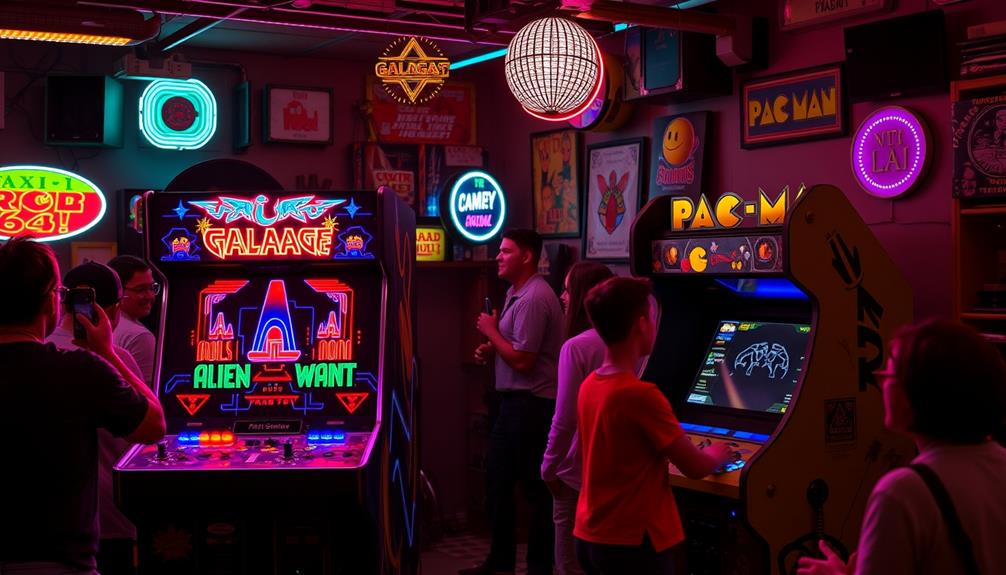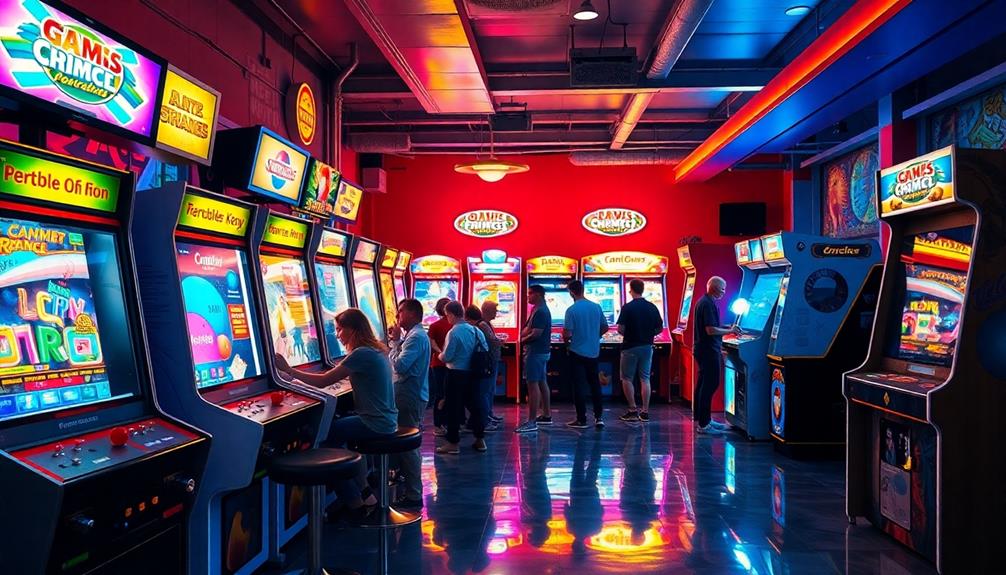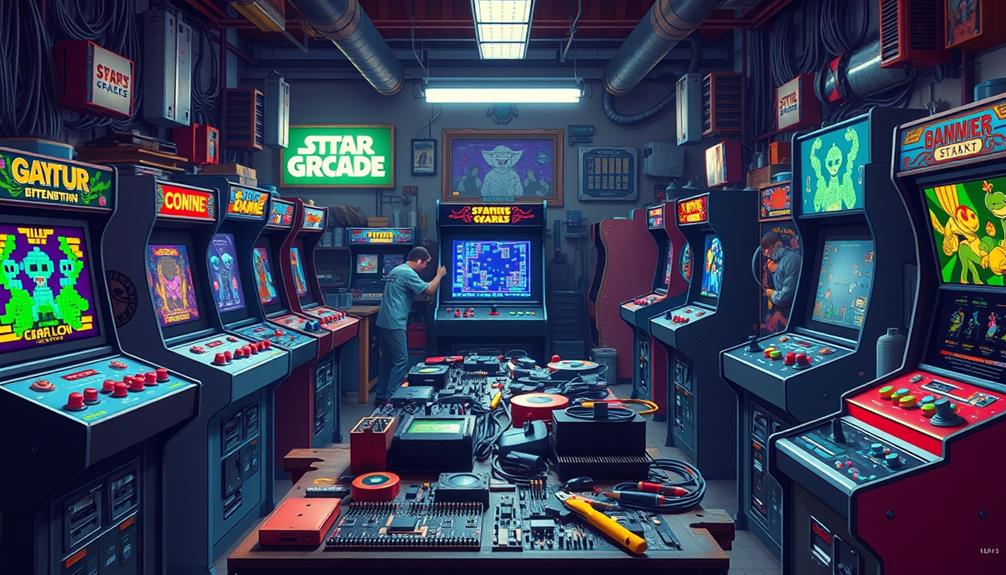If you're a fan of classic gaming, you can't ignore Galaga and Pac-Man. Released in the early 1980s, both games became cornerstones of arcade culture. Galaga challenges you to dodge enemy fire while rescuing captured ships, boosting your firepower. Meanwhile, Pac-Man invites you to navigate mazes while evading pesky ghosts. They've both left an indelible mark on gaming, inspiring many adaptations and a loyal fan base. Their nostalgic charm continues to draw in new players while celebrating retro gaming culture. Stick around to discover more about their legacy and how they shaped modern gaming experiences!
Key Takeaways
- Galaga and Pac-Man, released in the early 1980s, are iconic arcade games that defined the golden age of gaming.
- Galaga features strategic dual-fighter mechanics, while Pac-Man offers maze navigation and ghost-evading gameplay.
- Both games have inspired numerous sequels, adaptations, and cultural phenomena throughout the years.
- Nostalgia for these classics fuels their ongoing popularity and modern adaptations across various platforms.
- High score tournaments and community events celebrate their legacy, engaging new and veteran players alike.
Overview of Galaga and Pac-Man
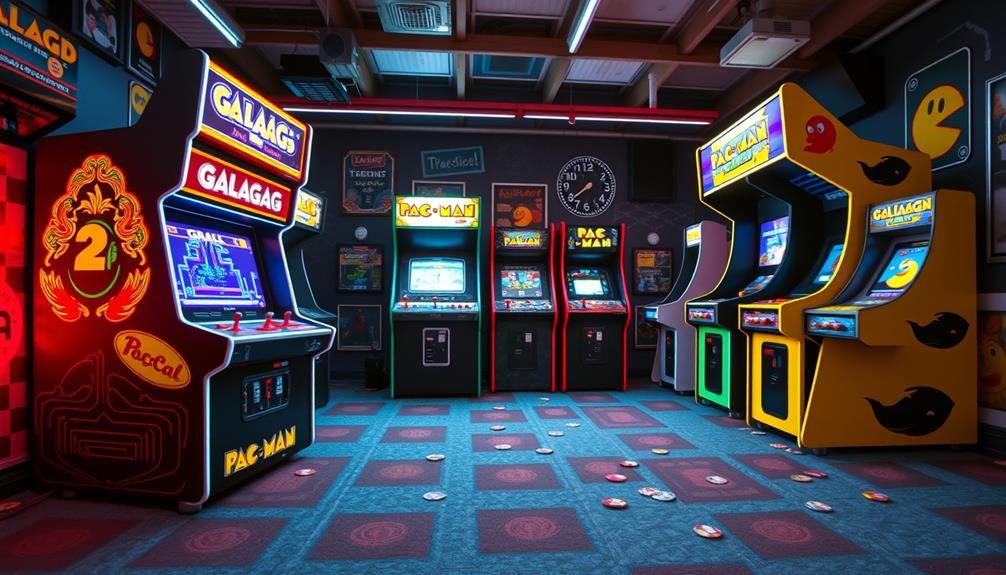
The enduring appeal of classic arcade games like Galaga and Pac-Man showcases the excitement and challenge they bring to players. Released in the early 1980s, both games became cornerstones of the golden age of arcade gaming.
Galaga, a fixed shooter, puts you in control of a starfighter battling formation-flying alien enemies. Its innovative dual-fighter mechanic allows you to rescue captured ships, boosting your firepower and intensifying the gameplay experience. The inclusion of Boss Galaga, with its tractor beam and the thrill of bonus stages, adds layers of strategy that keep players engaged.
On the other hand, Pac-Man features a yellow circular character maneuvering through a maze filled with dots while cleverly avoiding ghosts. Its unique gameplay mechanics and iconic design turned it into a cultural phenomenon, making it one of the most recognizable and successful video games of all time.
Together, these games have left a lasting legacy in the world of video games. Their combined influence has shaped countless adaptations and sequels, ensuring that both Galaga and Pac-Man remain beloved staples in arcade history and continue to inspire new generations of gamers.
Gameplay Mechanics and Innovations
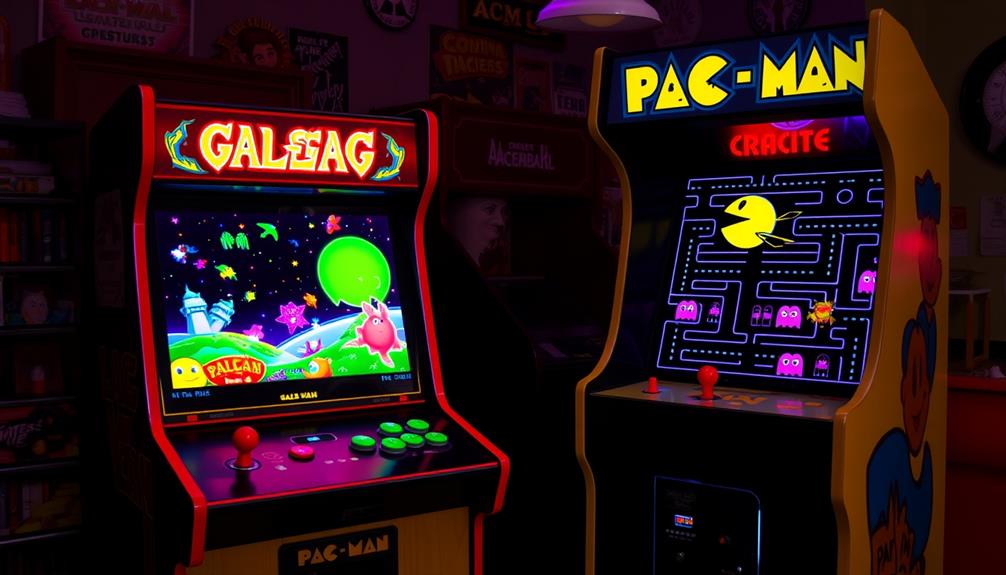
Since their debut, both Galaga and Pac-Man have introduced gameplay mechanics that not only challenge players but also keep them coming back for more.
In Galaga, you control a lone starfighter, using strategic movement to dodge enemy fire and defeat waves of aliens. The innovative dual-fighter mechanic allows you to rescue captured ships, enhancing your firepower and adding variety to the gameplay. This feature makes each session feel fresh and exciting.
On the other hand, Pac-Man captivates you with its simple yet addictive gameplay. You navigate mazes, mastering enemy patterns while utilizing hiding spots for strategic advantages. The thrill of evading ghosts and gobbling up pellets creates a compelling experience that's hard to resist.
Both games also incorporate unique bonus stages, particularly in Galaga, where you can shoot at preset enemy formations every fourth level without facing attacks. This break from combat not only offers a chance to score extra points but also adds depth to the arcade experience.
With innovations like 2-player simultaneous gameplay and adjustable lives in the Ms. Pac-Man/Galaga machine, these titles continue to set the standard for engaging arcade gameplay.
Development and Technical Challenges

Creating iconic arcade games like Galaga and Pac-Man came with considerable development and technical challenges. Developed by Shigeru Yokoyama and a small team at Namco, Galaga took about two months for initial planning, sparked by the success of its predecessor, Galaxian.
Shifting to new hardware led to the creation of the Namco Galaga arcade board, which greatly enhanced gameplay. However, the team faced hardware limitations that restricted the number of sprites displayed on screen. This challenge drove innovation, resulting in smaller sprites for ships and bullets, allowing for more dynamic action.
Early location tests for Galaga didn't meet expectations, prompting developers to adjust the game difficulty to engage players more effectively. One of the standout features, the dual-fighter mechanic, where you can rescue captured ships, was initially aimed at rewarding extra lives.
After refining this concept, it became a vital aspect that elevated gameplay dynamics, making it more enjoyable and strategic. These technical challenges shaped Galaga into a beloved classic, demonstrating how obstacles can fuel innovation in arcade game development.
Cultural Impact and Legacy
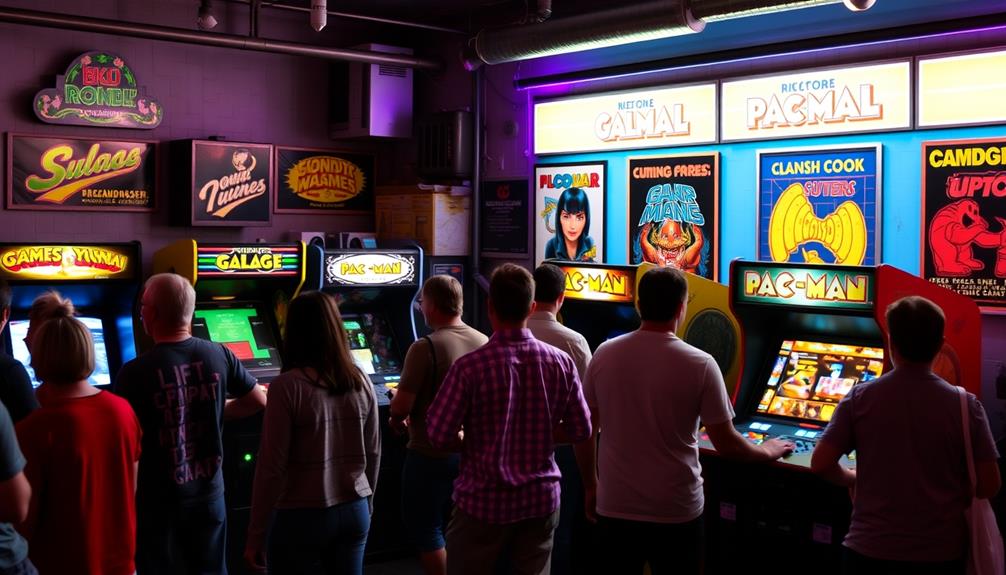
When you think about the cultural impact of Galaga and Pac-Man, their enduring popularity in gaming is hard to ignore.
These games haven't only shaped the arcade landscape but also influenced modern game design with their innovative mechanics.
As you explore their legacy, you'll see how they've inspired countless titles and continue to engage players today.
Enduring Popularity in Gaming
The enduring popularity of Galaga and Pac-Man highlights their significant cultural impact and lasting legacy in the gaming world. Both games have received critical acclaim, with Galaga often hailed as one of the greatest video games of all time, while Pac-Man stands as a cultural icon and the highest-grossing arcade game of its era.
Their widespread popularity is evident, as Galaga ranked as the sixth highest-grossing arcade game in Japan in 1981, appearing consistently on North America's RePlay magazine sales charts from 1980 to 1987.
Their enduring legacy is reflected in numerous compilations, merchandise, and adaptations, including an animated series based on Galaga. You'll find that both games have inspired countless sequels, spin-offs, and remakes, ensuring their relevance in modern gaming culture.
Additionally, they've made cameo appearances in popular films like WarGames and Pixels, further cementing their status in popular culture. The influence of these arcade games extends beyond gameplay, as they continue to inspire new generations of game designers and players alike.
Galaga and Pac-Man aren't just games; they're a demonstration of the power of gaming in shaping cultural experiences.
Influence on Game Design
Many gamers might not realize how profoundly Galaga and Pac-Man have shaped modern game design. Their innovative gameplay mechanics and enduring popularity have set benchmarks for player engagement and success in the arcade genre. Galaga's dual-fighter mechanic, for example, allows you to rescue captured ships for enhanced firepower, a concept that's echoed in many subsequent shoot 'em up titles. This influence extends to the fixed shooter format and unique enemy behaviors, which have become staples in today's arcade games.
| Aspect | Galaga & Pac-Man |
|---|---|
| Gameplay Mechanics | Dual-fighter & power-ups |
| Player Engagement | High scores and competitive play |
| Commercial Success | One of the highest-grossing |
| Critical Acclaim | Celebrated as classics |
| Cultural Significance | Featured in media and remakes |
The critical acclaim and commercial success of these titles have solidified their legacies as cornerstones of arcade culture. Their classic gameplay continues to resonate, ensuring that new generations of players experience their cultural significance and timeless fun.
Home Versions and Portability
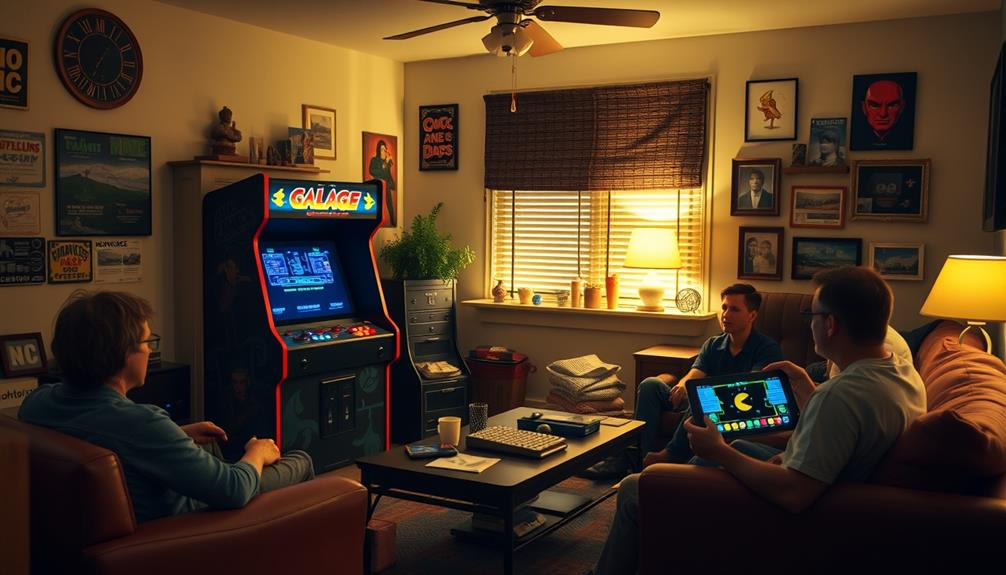
Since their arcade debut, both Galaga and Pac-Man have made impressive strides into home gaming, showcasing their versatility across various platforms.
The first home port of Galaga launched for the Sega SG-1000 in 1983, followed closely by versions for the MSX and Family Computer. Remarkably, the Nintendo Entertainment System's North American release of Galaga was titled "Demons of Death," proving the game's reach beyond arcade machines.
In 1995, a Game Boy version of Galaga hit the market, bundled with Galaxian, highlighting its adaptability to portable gaming systems. The enduring popularity of Galaga continued with its 2006 release on Xbox Live Arcade, offering a faithful arcade experience for modern consoles.
In 2013, the NES version made its way to the 3DS and Wii U via Virtual Console, introducing new audiences to this classic.
Additionally, mobile versions released in Japan in 2001 and 2006 demonstrate Galaga's successful change across platforms. This ability to thrive in different formats not only showcases the game's adaptability but also cements its status as a beloved classic among gamers of all ages.
Nostalgia and Modern Revivals
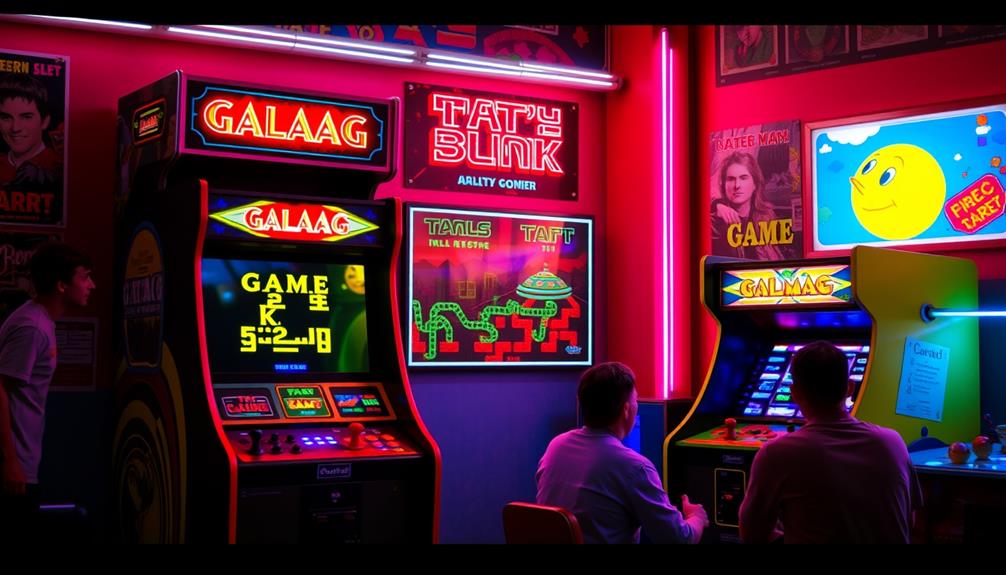
Nostalgia plays a significant role in the resurgence of classic arcade games like Galaga and Pac-Man, drawing in both longtime fans and new players alike. The enduring appeal of these games is evident in the popularity of the Ms. Pac-Man/Galaga arcade machine, which sold over 10,000 units since its release in 2001. Modern gaming continues to embrace their legacy through adaptations, including the upcoming "Galaga Chronicles" animated series.
Here's how these beloved titles connect with players today:
| Aspect | Galaga / Ms. Pac-Man |
|---|---|
| Original Release | 1981 / 1982 |
| Modern Compilations | Pac-Man's Arcade Party (2010) |
| High Score Record | 20,980,450 (Jordan Dorrington) |
| Retro Gaming Circles | Frequently Featured |
| Player Engagement | High Score Tournaments |
These classic arcade games frequently appear in compilations, keeping their spirit alive in retro gaming circles. Their nostalgic significance and community engagement guarantee that Galaga and Ms. Pac-Man remain relevant in today's gaming landscape, inviting new generations to experience their charm.
Frequently Asked Questions
What Is the Code for the Pac-Man Galaga Game?
You can access the original Pac-Man gameplay on the Ms. Pac-Man/Galaga machine by entering a specific code on the game select screen. Check your machine's manual for the exact sequence to use.
What Year Did Galaga Arcade Come Out?
You won't believe it, but Galaga burst onto the scene in 1981, enthralling players with its thrilling dual-fighter feature. This iconic game quickly became a staple in arcades, cementing its place in gaming history.
Is There an Ending to Galaga?
No, there isn't an ending to Galaga. You can keep playing as long as you have lives, facing tougher enemies and aiming for high scores instead of reaching a final level or conclusion.
What Is the Highest Selling Arcade Game of All Time?
If you're curious about arcade games, you'll find that "Pac-Man" holds the title for the highest-grossing arcade game ever, raking in over $2.5 billion since its 1980 debut, enchanting players worldwide.
Conclusion
In conclusion, Galaga and Pac-Man stand as shining symbols of the arcade era, enchanting countless gamers with their charm and challenge. Their groundbreaking gameplay and enduring influence guarantee they remain iconic favorites. Whether you're reliving nostalgic nights or discovering these classics for the first time, their timeless thrills continue to spark joy. So, dive back into these digital delights and celebrate the splendid spectacle that is arcade gaming's golden age!
